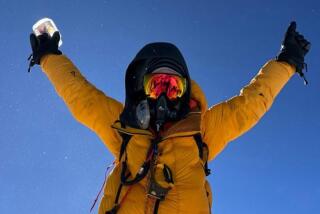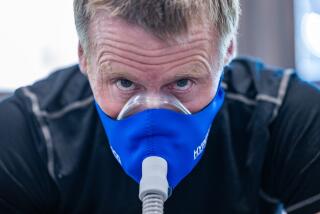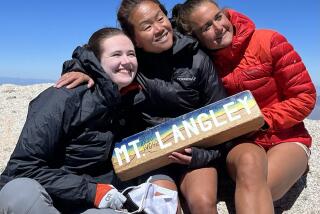Measured Ascent
There’s an old saying among mountaineers: There are old climbers and bold climbers, but no old, bold climbers. That was the catchphrase in the era of wool knickers and military-style expeditions that crept from camp to camp. Modern alpinists know there is safety in moving quickly with light loads. For one thing, it reduces the time they have to spend in the so-called Death Zone, the area above about 24,000 feet where the body is unable to revive from the ravages of altitude, and where a storm can be life-threatening.
Ed Viesturs, 45, of Bainbridge Island, Wash., is the perfect combination of the good and old: a strong, bold climber who has survived years of high-altitude mountaineering by carefully measuring the relative risk, to the point that his team once backed off from the 29,035-foot summit of Mt. Everest -- just 300 feet shy of the top -- for lack of rope. He retreated from Nepal’s 26,545-foot Annapurna twice before finally reaching the top in May. The climbing world had awaited Viesturs’ climb of Annapurna for some time -- not always patiently -- because it marked completion of his ascent of the 14 highest mountains in the world, those of 8,000 meters (26,247 feet) in elevation and above. Viesturs thus became the first American and only the 12th climber to achieve this, and he is only the fifth to climb them all without bottled oxygen. The first was the renowned Italian mountaineer Reinhold Messner, in 1986. All 14 peaks are in the greater Himalayan ranges, including portions of India, Pakistan, Nepal and China.
Viesturs’ feat was a long time coming. He topped his first, 28,168-foot Kanchenjunga, in 1989. Although Annapurna was the first 8,000-meter peak to be ascended, by a French team led by Maurice Herzog in 1950, it’s particularly dangerous, in part because of a band of seracs, ice towers that can collapse without warning. About four climbers have died on Annapurna for every 10 making the summit. Indeed, Viesturs’ team got caught in a whiteout on the descent and had to search three hours for their fixed ropes, essential to getting down.
And now? “I am retiring from climbing high mountains,” Viesturs told the Associated Press in Katmandu. He’ll still climb, but no more 8,000-meter peaks.
Bold when needed. Still not so old. And oh, so smart.
More to Read
Sign up for The Wild
We’ll help you find the best places to hike, bike and run, as well as the perfect silent spots for meditation and yoga.
You may occasionally receive promotional content from the Los Angeles Times.






